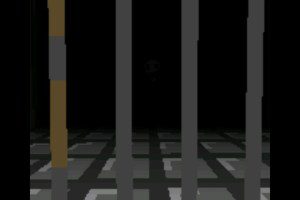The 10 Scariest Video Games of All Time
Though horror video games are rarely treated to the same all-night marathons, fan meet-and-greets, and ubiquitous merchandising that horror films benefit from, they aren’t any less impactful. Actually, the immersion of gaming forces players to engage with their perversity as active participants — with their hands on the controller, keyboard, or loose in VR space. Horror games have a knack for getting under people’s skin in many ways that movies can’t, lingering in players’ minds like the scenes of a car crash. It’s this intimate staying power that makes gaming a crucial part of the genre landscape.
From an evolutionary perspective, it makes sense that people like to scare themselves on purpose. On top of an adrenaline high, watching films like Carrie (1976), locked into the image of Sissy Spacek showering in blood on the prom night stage, prepares viewers for the cruelty of their capricious reality. Conversely, frightening themselves may make horror fans feel like they can handle acute danger — undead abominations, arrogant exes, deceitful serial killers — without actually putting themselves in any real peril. At least, that’s what scientists say.
Consider instead that horror may be more about looking inward. Sometimes, that’s literal, with games that pile gore and intestines up like loose sheets of toilet paper. Without an x-ray, how else could players become intimate with the curves of their organs? There’s a morbid thrill in this sort of self-discovery. In a horror game context, it lets players interact with death while being immune to it.
Horror is honest in that way, trusting fans to recognize the darkness rather than coddling them with “the assurance of being ourselves, that is, untouchable, unchangeable, immortal,” as Bulgarian-French philosopher Julia Kristeva writes about phobias in her 1980 essay book Powers of Horror. Scary games are also, you know, just kind of fun.
But while terrorizing players might be inherently easier in video games given the level of immersion and consequences, some games manage to elevate the artform to be on par with the cinematic greats. And while you’d think the most realistic games might be the ones to induce the most anxiety, developers have found all kinds of ways to contort the medium into nightmare fuel, regardless of the pixel count.
So, from surrealist indie throwbacks to descents into multiplayer madness, these are the ten scariest games of all time.
-
‘Imscared’ (2012)
Image Credit: Ivan Zanotti’s MyMadnessWorks The dreamlike first-person horror Imscared plays out like a bad hallucination from Benadryl. Its plot is evasive and fuzzy, which sometimes adds to that feeling, but the general idea is that the player themself is the game’s protagonist, and they are being spoken to IRL by the grinning demons inside the Imscared game file.
Before any action happens, a warning informs new players that “this game will try to deceive you as many times as it can.” That holds true. While following in-game instructions to escape Imscared ‘s circuitous low-poly rooms, players will encounter the entities White Face and HER. They make escape impossible, leering from black shadows as they bug and crash players’ games and create fourth-wall shattering, clickable files on their actual PC.
Though the game’s pixelated ghouls are about as cartoonishly scary as a bad haunted house, it’s hard to resist paranoia when it keeps showing up on a person’s desktop. This type of scare is both slow to build and to leave, making Imscared irresistible to anyone who wants to genuinely question their own sanity.
-
‘Five Nights at Freddy’s 4’ (2015)
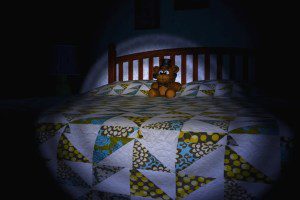
Image Credit: Scott Cawthon; Scottgames; Clickteam LLC USA The Five Nights at Freddy’s franchise has come to be associated with mall goth merchandise and an unremarkable Josh Hutcherson movie, but no one can forget the reason it ultimately became so famous: wildly effective jump scares. The first few games in the series delight in how their mangled animatronics sneak up on players, who are tasked with constantly monitoring claustrophobic rooms in the first-person.
No matter how many times you look down these animatronics’ unhinged jaws, a natural instinct to scream kicks in when a dirty yellow bird bot pops up from the dark with its razor teeth bared. And these jump scares are at their most diabolical in Five Nights at Freddy’s 4, which takes place in a child’s quiet bedroom.
The 2015 point-and-click game requires players survive five nights alone with sadistic animatronics, as per usual, with only a flashlight at their disposal. But FNaF 4 has a boosted, nightmarish quality to it. Its troupe of animatronics appear more desperate for flesh, with longer, sharper teeth and less skin on their decaying metal frames.
Since players assume the role of a vulnerable child rather than a willing employee like in past games, the set-up is more nauseating. Tension builds as the protagonist’s small feet patter on the carpet, running around toys to quickly check their closet and hallways for monsters. Too often, players will find these creatures staring at them with wolfish chomps bared. It’s a little funny, since they’re pizza parlor animatronics, but it’s hard to feel anything but quivering sobriety when they burst out and splatter blood on the screen.
-
‘P.T.’ (2014)

Image Credit: Konami P.T. was meant to function as a teaser for an ultimately abandoned new Silent Hill entry, though it’d be easy to be fooled otherwise. Unlike other Silent Hill games, P.T. operates in punishing first person, with a nameless protagonist. The house it’s set in is marginally less battered than the typical Silent Hill hovel, but this restraint is unsettling, especially as the 30-minute playable demo becomes more haunted. After a while, the suburban white walls in P.T. turn bloody bathed in thick red light, scored to the sound of a baby’s cry. Players will eventually find the misshapen fetus swollen and wriggling in the sink.
It’s sickeningly scary, but P.T. — a collaboration between Metal Gear Solid creator Hideo Kojima and Pan’s Labyrinth director Guillermo del Toro — is just as infamous as it is well regarded. For one, it serves only as a tease for a game that never came to fruition — Kojima’s planned Silent Hill installment, Silent Hills, got canceled after the developer and publisher Konami had an acrimonious breakup in 2015. Then, even as an experience, P.T. only offers about 30 minutes of play time (though its puzzles can take hours to ease apart). Today, the game isn’t even accessible to download unless you’ve still got it saved on your console.
But there’s a reason horror fans still discuss P.T. like it’s a unicorn. Walking through its creaking, photorealistic house in first person is traumatizing, especially once players discover the giggling apparition Lisa, who convulses in front of them and shoves her gritted, green teeth in your face. Its perfect pacing and paralyzingly freaky hauntings are unforgettable, and it remains a one-off oddity that the gaming community still clings to as one of the industry’s greatest what-if stories. As time moves one, P.T. practically becomes its own urban legend.
-
‘Phasmophobia’ (2020)

Image Credit: Kinetic Games Phasmophobia predates other recent horror co-op games like Lethal Company (2023) in finding genuine terror in the socially septic world of online gaming. The ghost-hunting simulation asks up to four players to collect evidence of hauntings using serious equipment like the Spirit Box, a hissing walkie-talkie for ghosts, and a standard-issue crucifix. Coordinating with friends is critical for players hoping to survive each infested property Phasmophobia sends them to. Progressing through levels unlocks increasingly aggressive ghosts, and high-level poltergeists can be quick in deciding they’d like players to be dead, too.
Players will need to rely on friends’ goodwill to keep them safe — a frightening proposition in its own right. Sometimes, despite the most well-meaning efforts, safety in Phasmophobia can feel as forever out of reach. The game often floats the line between scream-at-your-computer sinister and laughably janky.
In spite of this, suspense mounts as players shiver through seemingly empty properties, creeping room to room in anticipation of a specter to appear. They start to both hope and dread that something will happen. And, when a malevolent spirit inevitably appears to wrap its gray fingers around their skull to squeeze out the insides, they’ll be sweating too hard to worry about any shoddy game physics. Originally released in early access on PC in 2020, Phasmophobia is making its way to consoles — complete with VR support on PlayStation 5 — on Oct. 29.
-
‘Clock Tower’ (1995)
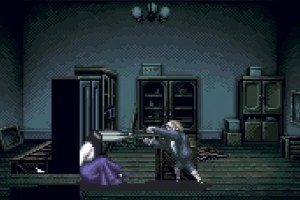
Image Credit: Human Entertainment The 1995 point-and-click survival horror game Clock Tower is both beautiful and excitingly bizarre. Inspired by Dario Argento’s 1985 film Phenomena, the supernatural plot centers around an orphan named Jennifer, who is modeled after Jennifer Connely, the actress who plays Jennifer (shocker) in the film.
The story begins with Jennifer’s teacher, Mary, escorting her to the imposing Clock Tower mansion to live with the rich hermit Simon, but he’s nowhere to be found. Instead, Jennifer quickly finds herself being shadowed by the malformed Scissorman. Obviously, he’s eager to plunge his torso-sized shears into her chest.
A product of its time, the game’s obscure puzzles sometimes slow this game loop down, but its jump scares are famously effective as the game randomizes the appearances of its clipper clad slasher. He could appear in any room you enter, or not at all.
Even with a murderous ogre chasing you around, Clock Tower cultivates an intoxicating mood with its pixel art. The mansion’s rooms are lovely — ornate and twilight blue — though the violence trapped behind their heavy doors is grisly. Later ports of the game even add FMV (full motion video) cut scenes, making its greasy sense of shlock even more impactful.
-
‘Rule of Rose’ (2006)

Image Credit: Sony Interactive Enterainmentl; Atlus Rule of Rose often is a gross and upsetting psychological horror title for the PlayStation 2. Its story depicts a 19-year-old orphan named Jennifer, who is being tortured by a secret society of children who call themselves the Red Crayon Aristocrat Club. Throughout, she’s forced to endure their punishments (they’re eager to murder her dog and bury her alive) until she recovers suppressed memories of her heartbreaking youth.
Despite its maliciousness, it’s an oddly tender game. Rule of Rose was subject to intense controversy around its 2006 release. In Europe, the game faced moral panic; Rome’s then-mayor Walter Veltroni begged for the game to be banned after Sony’s American division maintained that it “wasn’t really in sync with their corporate image.” A swirl of subsequent media reports ultimately ratched up the frenzy, and the U.K. did eventually ban Rule of Rose after enough publications associated it with obscene, underage torture.
But, while the game can indeed be cruel, it’s also fiercely beautiful. Jennifer is a girl who’s always been made to feel alone or afraid, and in helping her confront the bleakness of her childhood, players get the sense that she might sleep through the night for the first time ever. In the grand scheme, there aren’t many explicit scares here, but there is a pervasive feeling of emotional dusk and grief which make for a strikingly emotional form of horror.
-
‘Resident Evil 7: Biohazard’ (2017)
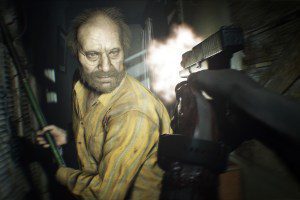
Image Credit: Capcom As one of gaming’s most enduringly popular survival horror franchises, Resident Evil has contributed nearly two decades of abominations to player’s nightmares. Out of the 10 mainline games (not including spin-offs and remakes), one in particular stands on the mangled zombified shoulders of the rest as the scariest of the lot: 2017’s Resident Evil 7: Biohazard.
Something of a soft reboot for the series, Resident Evil 7 brought the franchise back to its survival horror roots after a trio of games (4 to 6) that became increasingly action movie-esque. Trading in the third-person over-the-shoulder shooting of the previous games with a more intimate first-person perspective, it brings back the ever-present sense of dread the early games in the series traded in spades. Players become protagonist Ethan Winters as he explores the mud stained, bloodstained derelict house where his wife went missing, and it’s awful.
Unlike other Resident Evil heroes like Resident Evil 4‘s Leon or Resident Evil 5‘s Chris, Ethan isn’t a federal agent or specialist operator with a fat gun. He’s an engineer. He’s a husband. He’s ineffectual. The rot and illness that soak the Louisiana house he’s stuck in settle quicker because of his weakness. When he finally finds his wife, the skin under her eyes is completely cadaverous, and she helpfully removes his arm with a chainsaw. The betrayal of the moment, and Ethan’s aching scream, carry the kind of fear that echoes in the middle of the night.
Equal parts Night of the Living Dead and Texas Chainsaw Massacre, Resident Evil 7 brings the franchise to terrifying new heights, and is arguably the scariest experience available in VR.
-
‘Outlast’ (2013)
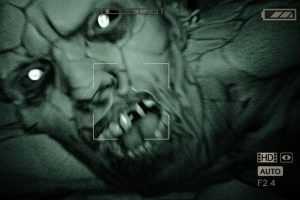
Image Credit: Red Barrels Over 10 years after its release, Outlast continues to be uniquely nasty. The story follows Miles Upshur, a plucky investigative journalist, who has decided to follow an anonymous tip that will uncover the corruption behind the scene in Mount Massive Asylum. But, with only a camcorder and notebook in his possession, Miles quickly finds himself unequipped to handle the depravity that waits for him inside.
Inside the asylum walls, he’s pursued by a cavalcade of homicidal maniacs. There’s Chris, an inmate the size of a wrestler on a metric ton of growth hormone. Sadistically grunting that Miles is a “little pig,” he chases him through Mount Massive, room by room in a sea of blood stained walls.
Players only have a meager handful of options to evade these relentless pursuers, like breathlessly squeezing themselves in lockers to hide or using their camera’s night vision to desperately search for their stalkers’ mutilated faces. Some are missing noses, and others are more than happy to cleave off players’ fingers without warning. But fading into the grotesque background of Mount Massive’s rancid surroundings won’t stop enemies from stabbing players many, many times with whatever they have on hand.
When Outlast released, its level of degeneracy was unseen in most games. Outlast is an innovator in pushing that boundaries for gaming carnage, the Saw of video games. It’s an experience that revels in bleak, X-rated misfortune in a way that will leave the squeamish vomiting up their popcorn.
-
‘Fatal Frame III: The Tormented’ (2005)

Image Credit: Koei Tecmo; Take-Two Interactive; Sony Interactive Entertainment The Fatal Frame games are especially frightening because of how vulnerable their protagonists are to the supernatural threats around them. In each installment, players can only defend themselves with the metaphysical Camera Obscura, which punishes evil spirits captured on its film. This level of fragility and tension is best exemplified by 2005’s Fatal Frame III: The Tormented, which unfolds in its three protagonists’ dreams as they encounter nauseating, grayish ghosts in the cursed Manor of Sleep.
Like Five Nights at Freddy’s, The Tormented plays heavily into the anticipation and delivery of effective jump scares, as the dream spirits appear instantly at any given moment from the dark side of its protagonists’ subconscious, dredging up the trauma they all experienced after losing loved ones. Players control the multiple characters in the third person, but the only way to tackle the horrific spirits assailing them is in the more claustrophobic, first-person perspective of the camera’s viewfinder.
The constantly shifting perspective, paired with the unpredictable nature of the ghouls gives The Tormented its bite. But it’s also a story of redemption and the acceptance of death. Its lead protagonist, Rei, is delicate and human, and there’s nothing to protect her from the hopelessness of her situation after losing her fiancé and now staring down the incorporeal spirits that yearn to drag her to their depths too. It’s more than just a game that trades in bone chilling surprises — although they’re plentiful — it’s also one that will drive home a deep realization that death is inevitable. And that pang will cut deeper than even the more effective jump scare; you won’t just be afraid of the dark, but just as fearful of what happens when you open your eyes in the light.
-
‘Amnesia: The Dark Descent’ (2010)

Image Credit: Frictional Games Amnesia: The Dark Descent is the gold standard of modern horror games. Released in 2010, at a time when the survival horror genre had been diluted to shooting galleries with gratuitous monsters, The Dark Descent offers a more insidious path. Its terror blossoms like a thorned rose, forcing players feel as powerless as possible. They’re at the whim of the game, not in command of it. They must submit to its madness, and it seems like no one can save them.
Shirking even the partial power fantasies that had pervaded horror gaming at the time, players must embody a frail protagonist. Daniel wakes up dizzy on the floor of the strange Brennenburg Castle. He remembers nothing, but he knows he’s being hunted. In first-person, players must guide Daniel deeper into the candlelit castle, which they’ll soon discover to be laminated in Daniel’s guilt. Yellowed notes reveal that, in his tormented attempts to repel the beastly “shadow” that follows him, Daniel himself became a beast as he tortured innocent people in hopes of harvesting their life force to save himself.
Now, his body is weak with the weight of his sins and his mind is even more fragile, so players have to avoid the dark to manage his waning sanity. The game’s black-eyed monsters are dead set on sending him over the edge, and witnessing their actions or spending too much time in the dark will cause Daniel to hallucinate and draw threats nearer. By basking in the light, players can try to bounce back, but it’s a precious resource, often relegated to a tinderbox lit candle or torch. And they always go out in the end.
Despite its deceptively simple but potent premise — shy away from the dark, run from the monsters — The Dark Descent inadvertently ushered in a new chapter for horror games. Subsequent releases in the genre, including many that appear on this list (like Outlast), built off its framework for combat-free horror that capitalizes on the innately human fear of powerlessness.
Innovative and sharply executed, it serves not just as the progenitor for countless games over the last near 15 years, but as a peerless exercise in absolute terror. Where other games go big, Amnesia remains subtle. Because what’s often most scary isn’t what you can see, but what you know is there just beyond the reaches of the dark.


